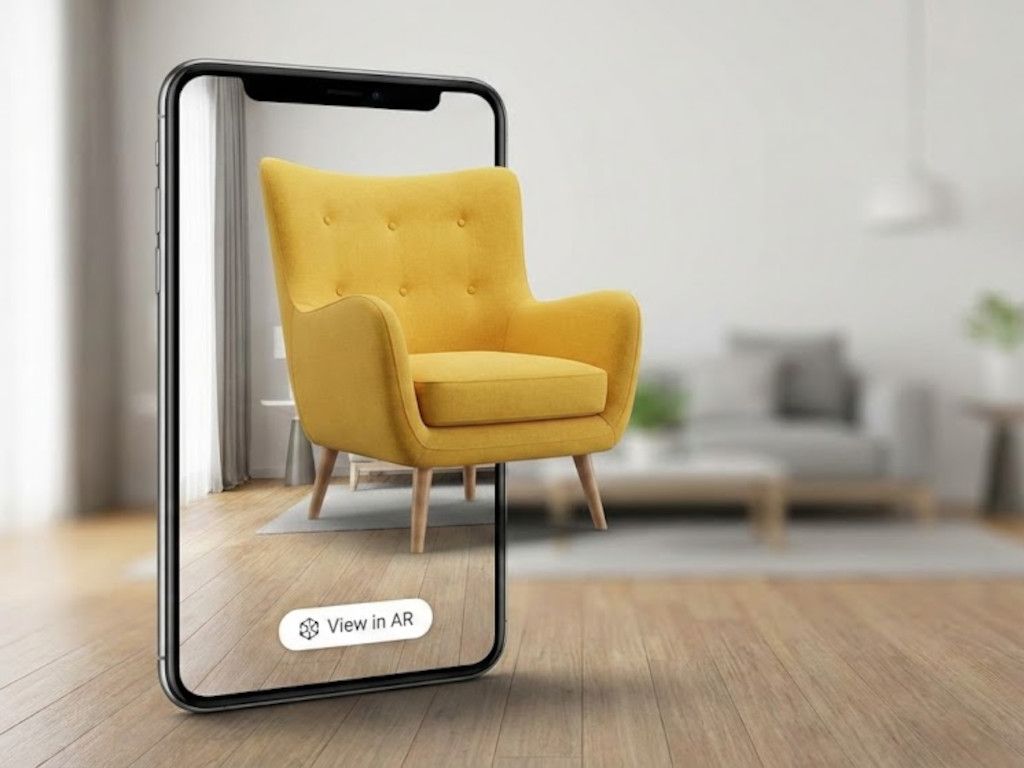If you’ve been keeping up with the latest tech trends, you’ve likely come across the terms Augmented Reality (AR) and Virtual Reality (VR). Did you know that you can let your customers view your products in 3D right on their smartphones?
In this article you will learn about necessary steps to integrate 3D and AR viewer with your Magento 2 store. Additionally, we’ll explore the costs associated with integrating an AR extension, including the 3D modeling of your products.
What is the cost of a 3D AR viewer?
The cost is split between the following aspects:
- integrating the viewer with your store
- CDN to serve 3D models
- 3D modelling
Integration with Magento 2 starts from 5000 USD. It depends on your theme customizations and features the viewer should use. Send us a message if you wish to add AR or 3D solution to your store or test AR on your phone now.
The basic model viewer for simple products displays one version of the model. Solutions with 3D swatches use the material variants extension. Then, a 3D designer has to prepare models with applied PBR materials and material variants.
Material Variants and their Limitations
Material variants let you model a product once and combine all surface versions within one file. If you have good quality models prepared for web (low poly) we can update them with desired variants.
They may need further customizations to work with configurable products having two or more swatches. For example, a sofa with a configurable body and legs would need as many variants as it has all possible combinations.
It means that for 8 material textiles and 4 types of legs, it is 8x4 = 32 variants.
In that case, the designer would have to define 32 material variants. This is a lot of unnecessary work.
Another limitation of material variants is texture duplication. It is not possible to reuse the same materials and textures across different models.
Material variants embed textures inside the glTF2.0 file.
However, it increases the model’s size while it could reuse shared textures already downloaded for other models.
Identical textures are downloaded every time for each model file.
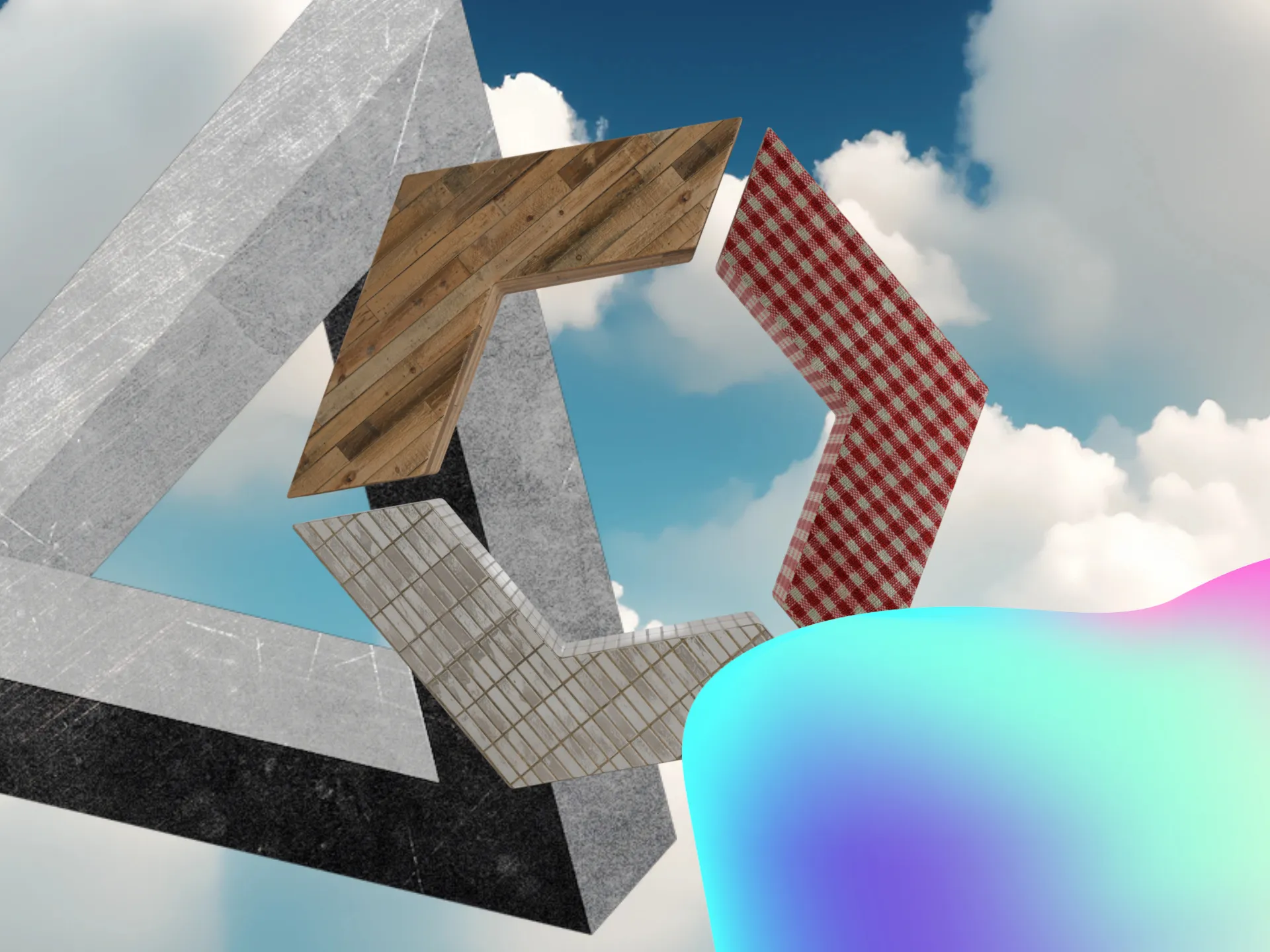
There is a smarter way to handle multiple product swatches in 3D.
Alternative to Material Variants
Our extension assigns textures dynamically for models, resulting in reduced downloaded file size. Moreover, each texture can be reused later with different product models when it is cached by the browser. Browser cache stores files on the client’s device which are then reused instantly without downloading.
This way, you specify material textures for each Magento swatch attribute once and assign them dynamically to products.
For example, a furniture store may have 10 velvets, 20 linens, and 10 wool material types and colors for the sofa body. Additionally, five kinds of wooden legs and four metal legs. Each material is assigned to the swatch attribute option and shared with all products using that attribute.
On the product page, loaded materials are limited to the available simple products within the configurable product.
Compare this with materials stored within the glTF file as variants: the model would have to keep (10 + 20 + 10) x (5 + 4) = 40 x 9 = 360 variants!
This method saves us a lot of 3D modeling work and your client’s network bandwidth. Optimizing file transfer is crucial as mobile devices may run on slower or paid network.
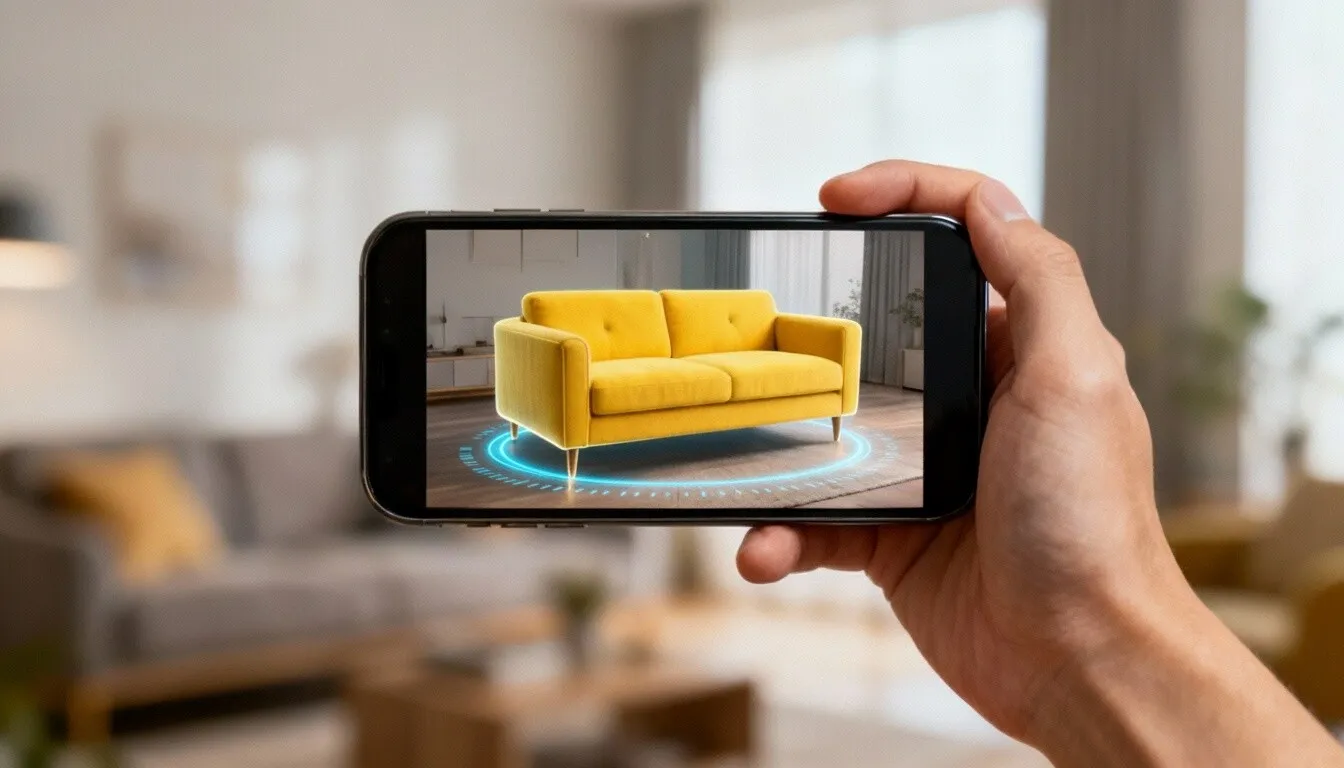
CDN for 3D Models and Textures
A CDN for 3D models and textures is important to quickly deliver them to your customers and reduce the pressure on your eCommerce store.
Your content management team can easily upload models to the CDN via FTP or the CDN dashboard. AWS CloudFront stands out as a relatively inexpensive and reliable option for this purpose.
The analogy where glTF2.0 is compared with JPG emerges on multiple surfaces. In eCommerce, CDN is mostly used for storing and delivering product pictures and videos. Here the same solution is applied as 3D models and textures source.
This way a single file name is added to the Magento 2 product attribute.
You can assign 3D model name to the product the same way as you would assign pictures. It is a universal solution that works with any method you use to manage the product information: CSV import, external PIM, Magento Admin Panel, or REST API.
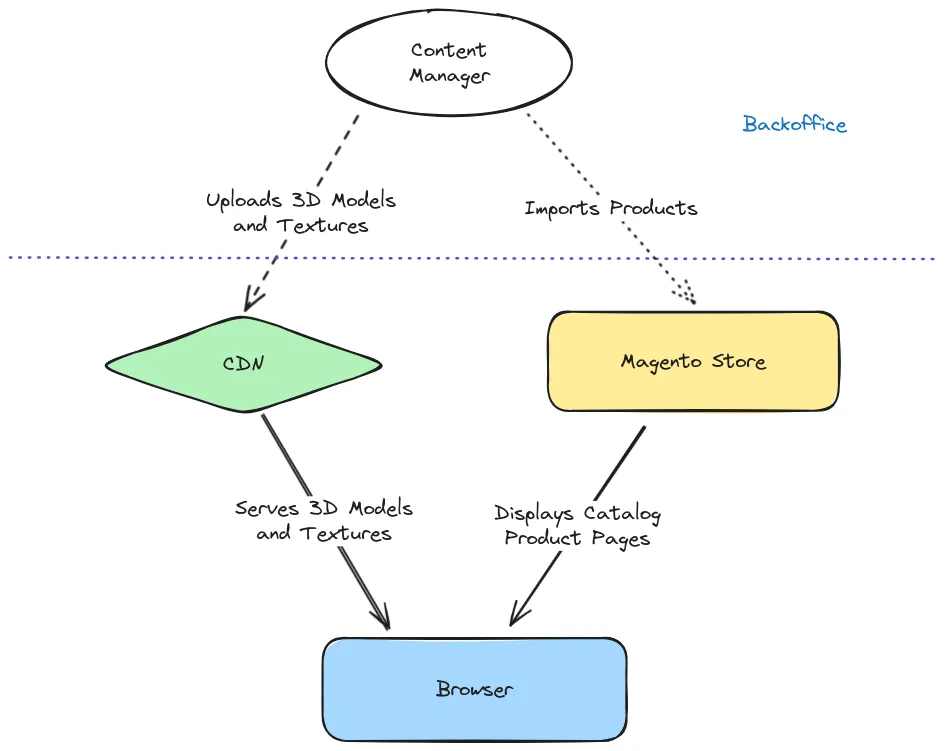
3D Modelling Cost
When it comes to 3D modeling costs, our pricing is based on an hourly rate of approximately 50 USD. For instance, a simple model like a power bank can typically be completed within 3 hours (150 USD). On the other hand, more intricate and detailed models may require 20 to 30 hours of work, with costs ranging from 1000 USD to 1500 USD.
To ensure a smooth and efficient process, it’s essential that you can prepare:
- blueprints or photographs of the product, taken from all important angles
- product dimensions
These documents are crucial for delivering high-quality 3D models that meet your specifications.
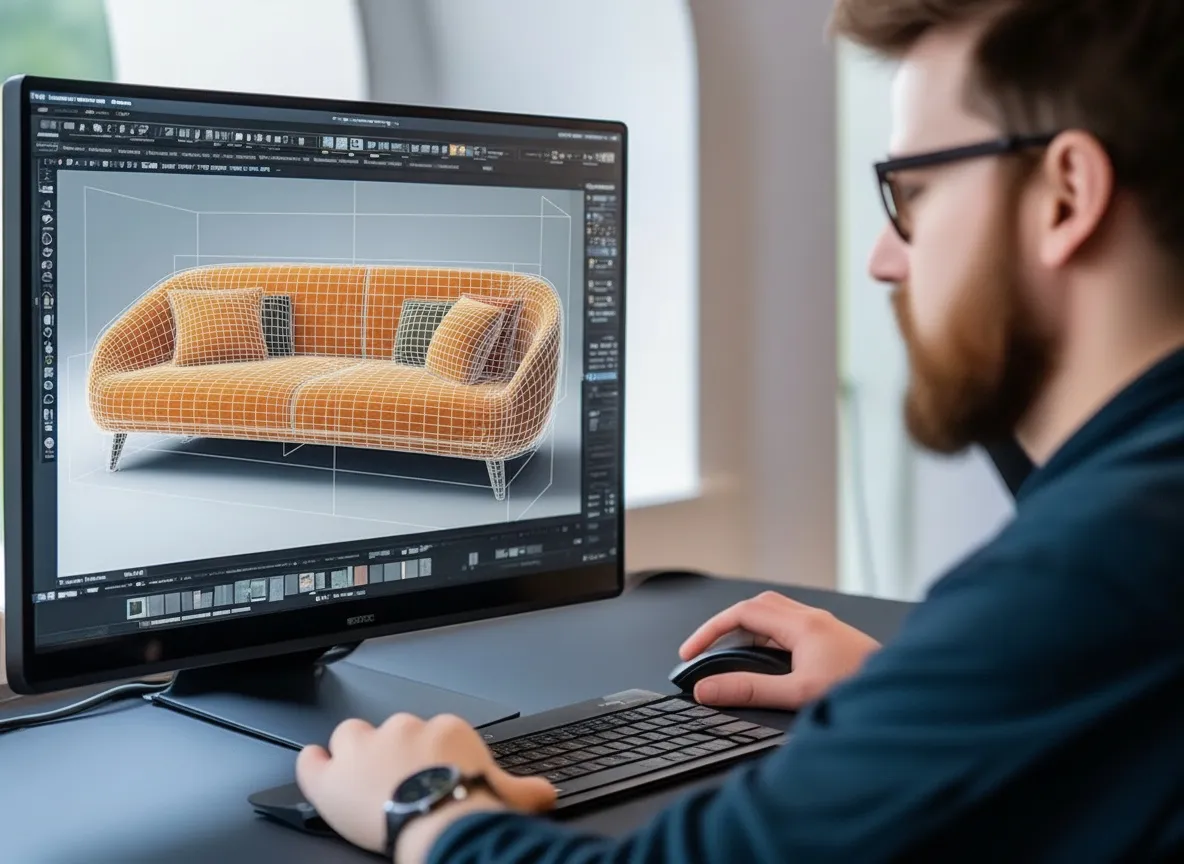
Alternative Sources of 3D Models for eCommerce
If your store sells products from popular brands, you can rely on publicly available models. Usually they are less expensive than models created from scratch or even free of charge.
Platforms like Sketchfab and TurboSquid offer a plethora of publicly available models that can be used for reselling popular brands’ products.
When you decide to stick with free models, make sure to understand the licensing details. It is often required to leave attribution about the author of the model. This helps maintain a professional approach to sourcing and using 3D models for your online store.
Treat Augmented Reality as Investment
Augmented Reality (AR) is no longer a fringe technology. It is rapidly becoming an integral part of digital commerce and interactive experiences.
Here’s an expanded view on why AR should be considered a serious investment in the context of eCommerce and the emerging metaverse:
Augmented Reality in Today’s Digital Landscape
With the advent of metaverse platforms and the increasing use of digital twins (virtual replicas of physical entities), AR provides an essential bridge between tangible and digital worlds. These technologies are reshaping how consumers interact with products and brands.
As AR becomes deeply ingrained with online shopping, it’s poised to become a standardized feature in eCommerce as 2D pictures are today. This implies that investments in AR today are foundational for the online consumer experience of tomorrow.

3D Models as a Stepping Stone
By developing AR models now, businesses are effectively laying the groundwork for future technologies proliferated by major marketplaces and retail giants. 3D models are valuable, long-term digital assets.
Ensuring that your AR models are compatible with platforms like Google Merchant Center prepares your business for seamless integration into larger ecosystems.

Investments and Standardizations by Industry Leaders
Google Merchant Center allows you to display 3D models on free listings via virtual_model_link attribute.
3D Merchant Center is available for US only and is limited to shoes and home goods.
With industry leaders like Nvidia investing in file formats like Universal Scene Description (USDZ) and using specifications like glTF 2.0 for projects like Omniverse, the direction toward a unified representation of 3D assets is clear.
Universal Scene Description describes the geometries, materials, physics, and behavior representations of 3D worlds and is the best open and extensible standard language for the 3D internet. — Jensen Huang, CEO, NVIDIA
Implications for Online Merchants
Stay informed about these emerging standards to ensure compatibility and future readiness for their digital assets.
Investing in AR means not just adopting the technology, but also investing in the skills, tools, and platforms that will power AR applications now and in the future. Prepare a strategic approach for AR initiatives that align with your long-term business goals and the overall advancement of digital commerce capabilities.
Align your business with the technological trajectories of major players and prepare for a future where eCommerce is immersive, interactive, and integrated with our lives.
How to Measure Augmented Reality ROI
Measuring the return on investment (ROI) of implementing augmented reality (AR) for your products is essential for understanding its impact on your business. By tracking customer engagement with AR, you can gain valuable insights into the success of your AR strategy.
Here’s a comprehensive guide on how to measure AR ROI and optimize your approach for maximum effectiveness.
Start with a Small Pool of Products
To begin measuring AR ROI, it’s best to start with a small range of products and closely monitor customer engagement with AR experiences. Focus on a limited number of products to gather specific and actionable data that will help you make informed decisions about the effectiveness of AR for your business.
Track Clicks on the AR Viewer Button
Utilize tools such as Google Analytics 4, Clarity, Matomo, or similar solutions to track and analyze customer interactions with the AR viewer button on your product pages.
Understand how well AR products are converting and can help you understand the impact of AR on customer behavior and purchasing decisions.
Compare Conversion Rates
Compare the new conversion rates after implementing AR with the conversion rates from before the introduction of AR experiences. This analysis will provide a clear understanding of AR’s impact on customer engagement and purchasing behavior.
Compare refunds to a sales ratio with historical reports.
Leverage A/B Testing
If you have experience with A/B testing, take advantage of this powerful method to measure the effectiveness of AR. Test different variations of AR experiences to understand customer preferences, engagement levels, and conversion rates.
Measuring the ROI of augmented reality for your products is essential for making informed business decisions and optimizing your AR strategy.
Implementing these strategies will provide you with actionable insights and enable you to make data-driven decisions to maximize the ROI of augmented reality for your products.
Conclusion
Integrating 3D and AR viewers with your Magento 2 store can be a valuable investment for enhancing the customer experience. The costs associated with this integration, including the necessary steps and considerations for 3D modeling, have been discussed in detail.
It’s important to factor in aspects such as integrating the viewer with your store and CDN for serving 3D models. Our integration with Magento starts from $5000 USD depending on customizations and features required by your theme.
Furthermore, serving models and textures through CDNs is crucial for seamless delivery to customers using mobile devices.
The importance of treating Augmented Reality (AR) as an investment has also been emphasized given its increasing significance in digital commerce. By laying the groundwork now through developing AR models compatible across platforms like Google Merchant Center and NVIDIA’s Omniverse ensures a future ready assets.
Measuring augmented reality ROI involves effective tracking of customer engagement which can provide actionable insights into its impact on business performance. Starting small by monitoring specific products’ performance through A/B testing allows you to make informed decisions about implementing AR experiences within your eCommerce strategy.
